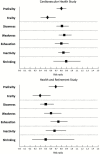Association of Frailty With Recovery From Disability Among Community-Dwelling Older Adults: Results From Two Large U.S. Cohorts
- PMID: 29648574
- PMCID: PMC6601525
- DOI: 10.1093/gerona/gly080
Association of Frailty With Recovery From Disability Among Community-Dwelling Older Adults: Results From Two Large U.S. Cohorts
Abstract
Background: Disability in activities of daily living (ADLs) is a dynamic process and transitions among different disability states are common. However, little is known about factors affecting recovery from disability. We examined the association between frailty and recovery from disability among nondisabled community-dwelling elders.
Methods: We studied 1,023 adults from the Cardiovascular Health Study (CHS) and 685 adults from the Health and Retirement Study (HRS), who were ≥65 years and had incident disability, defined as having difficulty in ≥1 ADL (dressing, eating, toileting, bathing, transferring, walking across a room). Disability recovery was defined as having no difficulty in any ADLs. Frailty was assessed by slowness, weakness, exhaustion, inactivity, and shrinking. Persons were classified as "nonfrail" (0 criteria), "prefrail" (1-2 criteria), or "frail" (3-5 criteria).
Results: In total, 539 (52.7%) CHS participants recovered from disability within 1 year. Almost two-thirds of nonfrail persons recovered, while less than two-fifths of the frail recovered. In the HRS, 234 (34.2%) participants recovered from disability within 2 years. Approximately half of the nonfrail recovered, while less than one-fifth of the frail recovered. After adjustment, prefrail and frail CHS participants were 16% and 36% less likely to recover than the nonfrail, respectively. In the HRS, frail persons had a 41% lower likelihood of recovery than the nonfrail.
Conclusions: Frailty is an independent predictor of poor recovery from disability among nondisabled older adults. These findings validate frailty as a marker of decreased resilience and may offer opportunities for individualized interventions and geriatric care based on frailty assessment.
Keywords: Disablement process; Frailty; Recovery; Resilience.
© The Author(s) 2018. Published by Oxford University Press on behalf of The Gerontological Society of America. All rights reserved. For permissions, please e-mail: journals.permissions@oup.com.
Figures


Similar articles
-
Association of Frailty with recovery from disability among community-dwelling Chinese older adults: China health and retirement longitudinal study.BMC Geriatr. 2020 Mar 30;20(1):119. doi: 10.1186/s12877-020-01519-6. BMC Geriatr. 2020. PMID: 32228463 Free PMC article.
-
Recovery from disability among community-dwelling older persons.JAMA. 2004 Apr 7;291(13):1596-602. doi: 10.1001/jama.291.13.1596. JAMA. 2004. PMID: 15069047
-
Early frailty transition predicts 15-year mortality among nondisabled older Mexican Americans.Ann Epidemiol. 2018 Jun;28(6):362-367.e3. doi: 10.1016/j.annepidem.2018.03.021. Epub 2018 Apr 12. Ann Epidemiol. 2018. PMID: 29703521 Free PMC article.
-
Quick and Simple FRAIL Scale Predicts Incident Activities of Daily Living (ADL) and Instrumental ADL (IADL) Disabilities: A Systematic Review and Meta-analysis.J Am Med Dir Assoc. 2018 Dec;19(12):1063-1068. doi: 10.1016/j.jamda.2018.07.019. Epub 2018 Sep 8. J Am Med Dir Assoc. 2018. PMID: 30206033
-
Frail Phenotype and Disability Prediction in Community-Dwelling Older People: A Systematic Review and Meta-Analysis of Prospective Cohort Studies.J Nurs Res. 2019 Jun;27(3):e28. doi: 10.1097/jnr.0000000000000299. J Nurs Res. 2019. PMID: 30747818 Free PMC article.
Cited by
-
The effect of positive thinking on resilience and life satisfaction of older adults: a randomized controlled trial.Sci Rep. 2023 Mar 1;13(1):3478. doi: 10.1038/s41598-023-30684-y. Sci Rep. 2023. PMID: 36859479 Free PMC article. Clinical Trial.
-
Association Between Number of Teeth, Denture Use and Frailty: Findings from the West China Health and Aging Trend Study.J Nutr Health Aging. 2020;24(4):423-428. doi: 10.1007/s12603-020-1346-z. J Nutr Health Aging. 2020. PMID: 32242210
-
Does a Reduction in Receiving Assistance With Daily Activities Among Older Adults in Mexico Indicate An Increase in Unmet Needs or a Decrease in Needs for Care?J Gerontol B Psychol Sci Soc Sci. 2024 Apr 1;79(4):gbad192. doi: 10.1093/geronb/gbad192. J Gerontol B Psychol Sci Soc Sci. 2024. PMID: 38142132 Free PMC article.
-
Quantifying resilience of humans and other animals.Proc Natl Acad Sci U S A. 2018 Nov 20;115(47):11883-11890. doi: 10.1073/pnas.1810630115. Epub 2018 Oct 29. Proc Natl Acad Sci U S A. 2018. PMID: 30373844 Free PMC article.
-
Integrating Frailty and Cognitive Phenotypes: Why, How, Now What?Curr Geriatr Rep. 2019 Jun;8(2):97-106. Epub 2019 Apr 24. Curr Geriatr Rep. 2019. PMID: 31815092 Free PMC article.
References
-
- Freedman VA, Martin LG, Schoeni RF. Recent trends in disability and functioning among older adults in the United States: a systematic review. JAMA. 2002;288:3137–3146. doi:10.1001/jama.288.24.3137 - PubMed
Publication types
MeSH terms
Grants and funding
- K08 AG051187/AG/NIA NIH HHS/United States
- HHSN268201200036C/HL/NHLBI NIH HHS/United States
- HHSN268200800007C/HL/NHLBI NIH HHS/United States
- N01HC55222/HL/NHLBI NIH HHS/United States
- N01HC85079/HL/NHLBI NIH HHS/United States
- N01HC85080/HL/NHLBI NIH HHS/United States
- N01HC85081/HL/NHLBI NIH HHS/United States
- N01HC85082/HL/NHLBI NIH HHS/United States
- N01HC85083/HL/NHLBI NIH HHS/United States
- N01HC85086/HL/NHLBI NIH HHS/United States
- U01 HL080295/HL/NHLBI NIH HHS/United States
- U01 HL130114/HL/NHLBI NIH HHS/United States
- R01 AG023629/AG/NIA NIH HHS/United States
- R03 AG048541/AG/NIA NIH HHS/United States
- P30 CA006973/CA/NCI NIH HHS/United States
- P30 AG031679/AG/NIA NIH HHS/United States
LinkOut - more resources
Full Text Sources
Other Literature Sources

